When Oriel Hill-Wilkinson was asked to open her home, Ross House, to guests her first reaction was: “Not a hope.” But living and farming near Lough Arrow in Riverchapel, a scenic part of Co Sligo where the trout fishing is exceptional, the local tourist office kept the pressure on.
“I told them I’d do one year and not to ask me do a second. That was the 1962-63 season and we are still in business.”

Oriel Hill-Wilkinson.
She opened with two guest rooms and back then en suite bathrooms were virtually non-existent. Her first guests were a couple from Belgium who booked in for one night and stayed a week, hiking and fishing. What’s more, they spread the word and their relations and friends also stayed in Ross House.
Oriel and her husband Nicholas met when both were students at Gurteen Agricultural College and they married in November 1972. With the arrival of children, Ross and Gemma, they kept the B&B going and expanded to five en suite rooms.
Take a cue from your guests
“Apart from en suites now being the norm I suppose the biggest change I’ve seen is the length of stay. In the past people stayed for a week and more, now you’d be lucky to have them for a second night. Providing full board that included an evening meal was also the norm when I started out.”
Oriel says the one essential for any B&B operator is to be there to welcome guests.
“You need to be there when guests arrive. That was important when I started out and it’s just as important today. Guests need to be welcomed, and that welcome should be personal.”
Second generation
Gemma Hill-Wilkinson grew up with the B&B and says it was like having a big family from all over the world.
“Families would stay for a week and we’d be off with them on days out and we’d have lots of children to play with. I remember one family always came to us from 1 July for 10 days and they did that for 20 years. From the time I was able to hold a plate, I was setting tables and the Irish dancing and singing was all part of it.”
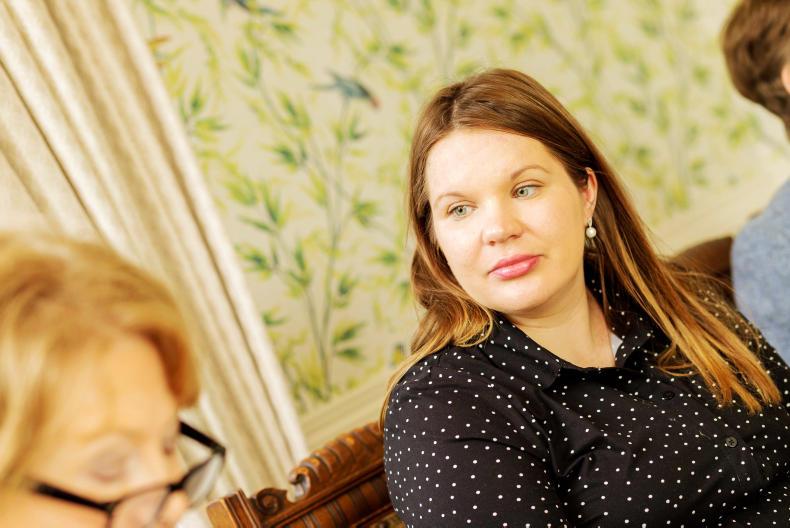
Gemma Hill-Wilkinson.
Gemma trained as a montessori teacher but still helped out during busy weekends and festivals. Five years ago, she moved back to Sligo with her own family and got fully involved in the business. Like her mother and grandmother Gemma’s seven-year-old daughter Lola is well able to chat with their guests and bring in the morning toast.
Oriel says Gemma is a whizz on-line. “We get a great reaction from posting photos on Facebook and Instagram, it always encourages bookings. We connect as a farmhouse stay, with the Wild Atlantic Way and the Miner’s Way. There’s also great interest in activity-based weekends with good food. It all helps.”
A tough beginning
Mary Mulligan’s introduction to running a B&B was a baptism of fire. She married Padraig in September 1973 and they returned from their honeymoon to find their dairy herd wiped out with brucellosis.
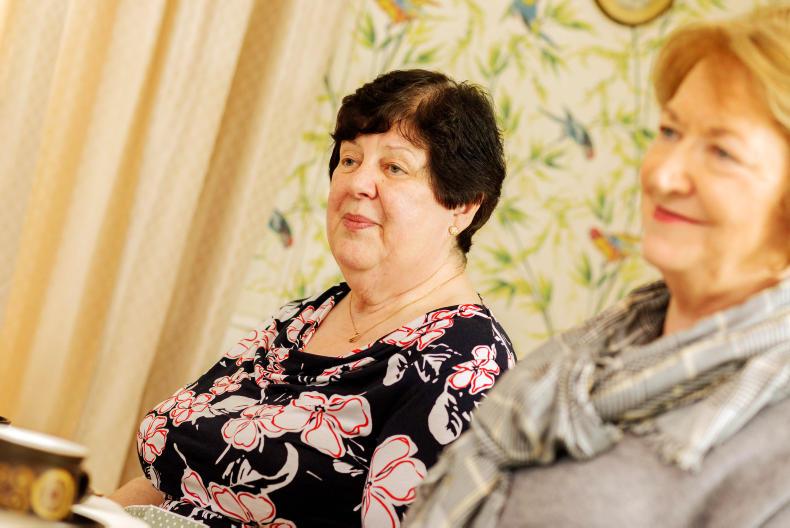
Mary Mulligan (left) and Brenda McTigue (right).
“It was some start to married life,” she says. “We faced into an empty yard and I will never forget it. What’s more, I’d been working with Bank of Ireland and with the marriage bar I had to give up my job. But the law changed and I was offered my old job back. It was a Godsend. That was October 1973 and my claim to fame is that I was the first married woman to work for Bank of Ireland. I was paid £12 a week and £5 of that went in tax.”
Mary says the Department of Agriculture were supportive and they were able to restock relatively quickly. “Thank God that was the first and only time we were hit with brucellosis.”
Looking for a loan
In another nugget of social history Mary says that back in the early 1970s banks wouldn’t give a mortgage to a married woman. Women were only allowed borrow to buy a car or furniture. Mary used these loans to the maximum to put the finishing touches to her new home and have it ready for guests the following May.
“Our farm is located on Aughris Head in Sligo, and it’s just spectacular so tourism was an obvious choice for us. We opened on 1 June 1974 with three bedrooms. It was a few years before we added sinks to the rooms but we had two family bathrooms and that helped.”
Interested in the farm
When the children started to arrive, Mary fitted the business around them and her work in the bank. As to how things have changed over the years, Mary says guests have a lot of interest in the farming aspect of her home.
“These days, visitors are a lot more interested in what we do as dairy farmers. We recently built a new rotary milking parlour for our 700-cow herd. When doing the work, we added a viewing area and children love it and learn a lot from it. It’s an area we plan to expand on in the future.”
Teagasc opened eyes to new possibilities
Brenda McTigue married Michéal in 1977 and moved to Clareview House, a busy family dairy farm near the village of Kinvara in Co Galway. Between the farm and the arrival of four children in six years Brenda had her hands full. However, by the time the children had all started school she had time on her hands and was itching to do something new.
I started the course and I loved it. I learned so much and it opened my eyes to all sorts of possibilities
“I thought I might go back to work outside the farm. Opening a B&B wasn’t on the agenda at all,” she says. Then she came across a rural development course being run by Michael O’Sullivan and Maria Heneghan of Teagasc. “I started the course and I loved it. I learned so much and it opened my eyes to all sorts of possibilities. And that’s when the idea of opening our home to guests came about.”
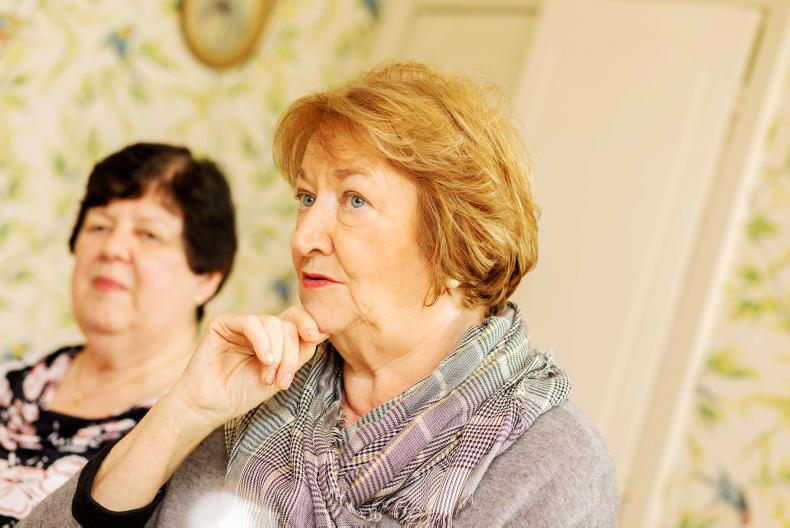
Brenda McTigue with Mary Mulligan in the background.
Before starting the business in 1993 Brenda installed en suites in her three guest rooms. She also registered with Bórd Fáilte and joined Irish Farmhouse Holidays.
“I clearly remember attending a meeting of members in Castlebar and the room was packed but I knew nobody. Then the new members were asked to introduce ourselves and I got the fright of my life.” Today Brenda is director of B&B Ireland for the western region
Shannon and Knock airports need promoting
When Brenda started out she was subject to one inspection a year. Now there are multiple inspections and more agencies doing the inspecting.
She strongly believes that more needs to be done to publicise both Knock and Shannon Airports.
“Americans know nothing about these airports. They arrive into Dublin airport, rent a car and are stressed out by the time they’ve hit the M50. These airports are essential for tourism in the west of Ireland.
“The Wild Atlantic Way (WAW) has been a huge bonus but easy access to the region is essential and that’s why Knock and Shannon are so important.”
‘What’s the Wi-Fi code?’ is the first question you are asked
Mary Mulligan vouches for the impact of the WAW on tourism numbers.
“Just before the WAW was launched my daughter was working with me for the summer and things were very quiet.
“To be honest, I was thinking of closing, but the impact of WAW was immediate. It just goes to show the importance of good marketing.”
While en suite bathrooms are essential today so too is good Wi-Fi.
“‘What’s the Wi-Fi code?’ is the first question you are asked. People don’t understand when [the signal] goes down. Broadband is essential for bookings, for publicity for everything really,” says Mary.
Catherine O’Hara spent time in London and Dublin before returning to Ballina to work as a bookkeeper. She married Eamon in 1971 and here again we see how women were discriminated against once they married.
We’d great scenery, a warm welcome, good-quality local and organic food, three guest bedrooms with hot and cold water and it was suggested to us that B&B was an option
“It was tough for women back then and it wasn’t easy to get a job as a married woman. To add insult to injury, we were paid less as well. That’s the way it was back then. Most women were in the same boat,” she says.
By the early 1980s Catherine and Eamon were well settled in Enniscrone, Co Sligo, and had four little girls under 10. They had a new-ish house with hot and cold water in each bedroom.
“We’d great scenery, a warm welcome, good-quality local and organic food, three guest bedrooms with hot and cold water and it was suggested to us that B&B was an option,” says Catherine.
The couple toured the country staying in B&Bs to see how it was done and were hooked on the idea.
Catherine put up their sign for Tara B&B on the week after 12 July 1984 and never looked back. “In the early days our guests were mainly from Northern Ireland, but now they are mainly European, American, Australian and Canadian.”
Early influencers
Oriel credits Nancy Fitzgerald and Dilly Griffey who started the Farmhouse B&B Association with being a big influence on the sector. Brenda McTigue adds Eileen McDonogh to that list.
“They were very practical women who believed women needed both their independence and incomes of their own. Thanks to them many new operators got into the business.”
You are very tied to the place and that doesn’t suit some people
Mary Mulligan acknowledges that running a busy B&B isn’t easy and more young people are needed in the sector.
“You are very tied to the place and that doesn’t suit some people. But it has its compensations, especially when it comes to being at home with your children.”
Catherine says women are better educated and have more choice when it comes to careers.
Positives far outweigh the negatives
So while all agree there are some drawbacks to running a B&B they equally agree the positives far outweigh the negatives.
“For a start your house will be in good order. Then there’s flexibility around childcare. Being a parent at home is wonderful. And you are also there for grandchildren,” says Brenda.
Lots of families have lovely new houses and I think doing B&B is something they could consider
“Running a B&B gives you a private income and your independence,” says Mary. “I love being at home with family close by to help out. And I like my own money,” adds Catherine.
“Life is tough for young families especially when both partners work outside the home. Then the cost of keeping children in childcare is huge.
“Lots of families have lovely new houses and I think doing B&B is something they could consider,” says Brenda.
“What I like about the B&B is that it’s very flexible, I can drop my daughter to school and do the jobs and it works well with mum. As for the house, our policy is to take a room a year and give it a full makeover,” says Gemma.
We have high chairs and cots and plenty of space to play. All that takes the stress out of travel
All agree that Airbnb has taken some business but they say the product is totally different to a family-run B&B with home cooking and the personal touch. “A B&B holiday is perfect for young families,” says Oriel.
“We have high chairs and cots and plenty of space to play. All that takes the stress out of travel.” Mary says they get a lot of farming guests. “I suppose farmers are comfortable with other farmers.”
Apart from social media, all the operators say they get great support from B&B Ireland. Limerick Travel and Green Ireland are other good booking platforms.
They would tell anyone thinking of doing B&B to register with Fáilte Ireland as their supports are really valuable.
While public liability insurance is a concern, B&B Ireland has a group scheme with FBD Insurance to cover its members. All would like to see more training days similar to those run by Fáilte Ireland in the past.
We will leave the final word with Oriel who hosted the group beautifully on the day. “If you had told me back in 1962 that I’d still be in the business, I wouldn’t have believed you. But I am and I love it as much today as at any stage in the past 57 years. It’s wonderful to have Gemma involved, to have that continuity in what I think is a wonderful career.”
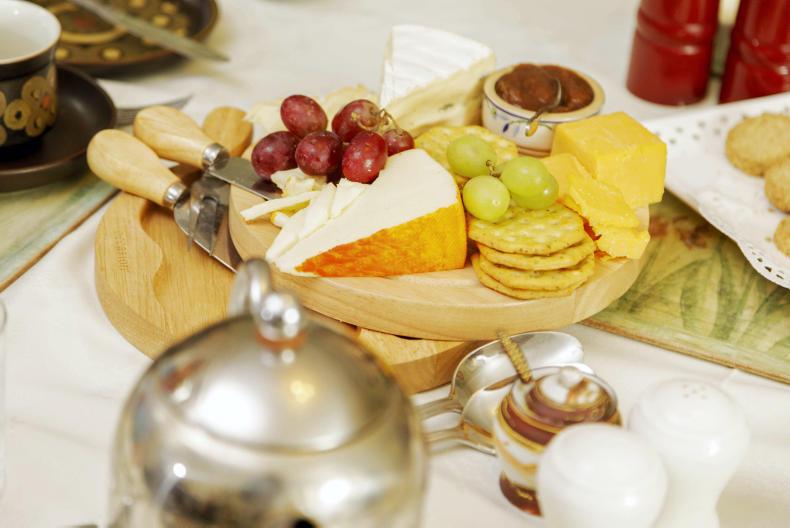
With 700 homes on its register B&B Ireland is the largest promotional body for the B&B sector on the island of Ireland. All homes are certified by the Irish tourist board or by B&B Ireland’s own quality framework. It’s website www.bandbireland.com offers clients a window to the largest collection of B&B homes in Ireland.
When Oriel Hill-Wilkinson was asked to open her home, Ross House, to guests her first reaction was: “Not a hope.” But living and farming near Lough Arrow in Riverchapel, a scenic part of Co Sligo where the trout fishing is exceptional, the local tourist office kept the pressure on.
“I told them I’d do one year and not to ask me do a second. That was the 1962-63 season and we are still in business.”

Oriel Hill-Wilkinson.
She opened with two guest rooms and back then en suite bathrooms were virtually non-existent. Her first guests were a couple from Belgium who booked in for one night and stayed a week, hiking and fishing. What’s more, they spread the word and their relations and friends also stayed in Ross House.
Oriel and her husband Nicholas met when both were students at Gurteen Agricultural College and they married in November 1972. With the arrival of children, Ross and Gemma, they kept the B&B going and expanded to five en suite rooms.
Take a cue from your guests
“Apart from en suites now being the norm I suppose the biggest change I’ve seen is the length of stay. In the past people stayed for a week and more, now you’d be lucky to have them for a second night. Providing full board that included an evening meal was also the norm when I started out.”
Oriel says the one essential for any B&B operator is to be there to welcome guests.
“You need to be there when guests arrive. That was important when I started out and it’s just as important today. Guests need to be welcomed, and that welcome should be personal.”
Second generation
Gemma Hill-Wilkinson grew up with the B&B and says it was like having a big family from all over the world.
“Families would stay for a week and we’d be off with them on days out and we’d have lots of children to play with. I remember one family always came to us from 1 July for 10 days and they did that for 20 years. From the time I was able to hold a plate, I was setting tables and the Irish dancing and singing was all part of it.”

Gemma Hill-Wilkinson.
Gemma trained as a montessori teacher but still helped out during busy weekends and festivals. Five years ago, she moved back to Sligo with her own family and got fully involved in the business. Like her mother and grandmother Gemma’s seven-year-old daughter Lola is well able to chat with their guests and bring in the morning toast.
Oriel says Gemma is a whizz on-line. “We get a great reaction from posting photos on Facebook and Instagram, it always encourages bookings. We connect as a farmhouse stay, with the Wild Atlantic Way and the Miner’s Way. There’s also great interest in activity-based weekends with good food. It all helps.”
A tough beginning
Mary Mulligan’s introduction to running a B&B was a baptism of fire. She married Padraig in September 1973 and they returned from their honeymoon to find their dairy herd wiped out with brucellosis.

Mary Mulligan (left) and Brenda McTigue (right).
“It was some start to married life,” she says. “We faced into an empty yard and I will never forget it. What’s more, I’d been working with Bank of Ireland and with the marriage bar I had to give up my job. But the law changed and I was offered my old job back. It was a Godsend. That was October 1973 and my claim to fame is that I was the first married woman to work for Bank of Ireland. I was paid £12 a week and £5 of that went in tax.”
Mary says the Department of Agriculture were supportive and they were able to restock relatively quickly. “Thank God that was the first and only time we were hit with brucellosis.”
Looking for a loan
In another nugget of social history Mary says that back in the early 1970s banks wouldn’t give a mortgage to a married woman. Women were only allowed borrow to buy a car or furniture. Mary used these loans to the maximum to put the finishing touches to her new home and have it ready for guests the following May.
“Our farm is located on Aughris Head in Sligo, and it’s just spectacular so tourism was an obvious choice for us. We opened on 1 June 1974 with three bedrooms. It was a few years before we added sinks to the rooms but we had two family bathrooms and that helped.”
Interested in the farm
When the children started to arrive, Mary fitted the business around them and her work in the bank. As to how things have changed over the years, Mary says guests have a lot of interest in the farming aspect of her home.
“These days, visitors are a lot more interested in what we do as dairy farmers. We recently built a new rotary milking parlour for our 700-cow herd. When doing the work, we added a viewing area and children love it and learn a lot from it. It’s an area we plan to expand on in the future.”
Teagasc opened eyes to new possibilities
Brenda McTigue married Michéal in 1977 and moved to Clareview House, a busy family dairy farm near the village of Kinvara in Co Galway. Between the farm and the arrival of four children in six years Brenda had her hands full. However, by the time the children had all started school she had time on her hands and was itching to do something new.
I started the course and I loved it. I learned so much and it opened my eyes to all sorts of possibilities
“I thought I might go back to work outside the farm. Opening a B&B wasn’t on the agenda at all,” she says. Then she came across a rural development course being run by Michael O’Sullivan and Maria Heneghan of Teagasc. “I started the course and I loved it. I learned so much and it opened my eyes to all sorts of possibilities. And that’s when the idea of opening our home to guests came about.”

Brenda McTigue with Mary Mulligan in the background.
Before starting the business in 1993 Brenda installed en suites in her three guest rooms. She also registered with Bórd Fáilte and joined Irish Farmhouse Holidays.
“I clearly remember attending a meeting of members in Castlebar and the room was packed but I knew nobody. Then the new members were asked to introduce ourselves and I got the fright of my life.” Today Brenda is director of B&B Ireland for the western region
Shannon and Knock airports need promoting
When Brenda started out she was subject to one inspection a year. Now there are multiple inspections and more agencies doing the inspecting.
She strongly believes that more needs to be done to publicise both Knock and Shannon Airports.
“Americans know nothing about these airports. They arrive into Dublin airport, rent a car and are stressed out by the time they’ve hit the M50. These airports are essential for tourism in the west of Ireland.
“The Wild Atlantic Way (WAW) has been a huge bonus but easy access to the region is essential and that’s why Knock and Shannon are so important.”
‘What’s the Wi-Fi code?’ is the first question you are asked
Mary Mulligan vouches for the impact of the WAW on tourism numbers.
“Just before the WAW was launched my daughter was working with me for the summer and things were very quiet.
“To be honest, I was thinking of closing, but the impact of WAW was immediate. It just goes to show the importance of good marketing.”
While en suite bathrooms are essential today so too is good Wi-Fi.
“‘What’s the Wi-Fi code?’ is the first question you are asked. People don’t understand when [the signal] goes down. Broadband is essential for bookings, for publicity for everything really,” says Mary.
Catherine O’Hara spent time in London and Dublin before returning to Ballina to work as a bookkeeper. She married Eamon in 1971 and here again we see how women were discriminated against once they married.
We’d great scenery, a warm welcome, good-quality local and organic food, three guest bedrooms with hot and cold water and it was suggested to us that B&B was an option
“It was tough for women back then and it wasn’t easy to get a job as a married woman. To add insult to injury, we were paid less as well. That’s the way it was back then. Most women were in the same boat,” she says.
By the early 1980s Catherine and Eamon were well settled in Enniscrone, Co Sligo, and had four little girls under 10. They had a new-ish house with hot and cold water in each bedroom.
“We’d great scenery, a warm welcome, good-quality local and organic food, three guest bedrooms with hot and cold water and it was suggested to us that B&B was an option,” says Catherine.
The couple toured the country staying in B&Bs to see how it was done and were hooked on the idea.
Catherine put up their sign for Tara B&B on the week after 12 July 1984 and never looked back. “In the early days our guests were mainly from Northern Ireland, but now they are mainly European, American, Australian and Canadian.”
Early influencers
Oriel credits Nancy Fitzgerald and Dilly Griffey who started the Farmhouse B&B Association with being a big influence on the sector. Brenda McTigue adds Eileen McDonogh to that list.
“They were very practical women who believed women needed both their independence and incomes of their own. Thanks to them many new operators got into the business.”
You are very tied to the place and that doesn’t suit some people
Mary Mulligan acknowledges that running a busy B&B isn’t easy and more young people are needed in the sector.
“You are very tied to the place and that doesn’t suit some people. But it has its compensations, especially when it comes to being at home with your children.”
Catherine says women are better educated and have more choice when it comes to careers.
Positives far outweigh the negatives
So while all agree there are some drawbacks to running a B&B they equally agree the positives far outweigh the negatives.
“For a start your house will be in good order. Then there’s flexibility around childcare. Being a parent at home is wonderful. And you are also there for grandchildren,” says Brenda.
Lots of families have lovely new houses and I think doing B&B is something they could consider
“Running a B&B gives you a private income and your independence,” says Mary. “I love being at home with family close by to help out. And I like my own money,” adds Catherine.
“Life is tough for young families especially when both partners work outside the home. Then the cost of keeping children in childcare is huge.
“Lots of families have lovely new houses and I think doing B&B is something they could consider,” says Brenda.
“What I like about the B&B is that it’s very flexible, I can drop my daughter to school and do the jobs and it works well with mum. As for the house, our policy is to take a room a year and give it a full makeover,” says Gemma.
We have high chairs and cots and plenty of space to play. All that takes the stress out of travel
All agree that Airbnb has taken some business but they say the product is totally different to a family-run B&B with home cooking and the personal touch. “A B&B holiday is perfect for young families,” says Oriel.
“We have high chairs and cots and plenty of space to play. All that takes the stress out of travel.” Mary says they get a lot of farming guests. “I suppose farmers are comfortable with other farmers.”
Apart from social media, all the operators say they get great support from B&B Ireland. Limerick Travel and Green Ireland are other good booking platforms.
They would tell anyone thinking of doing B&B to register with Fáilte Ireland as their supports are really valuable.
While public liability insurance is a concern, B&B Ireland has a group scheme with FBD Insurance to cover its members. All would like to see more training days similar to those run by Fáilte Ireland in the past.
We will leave the final word with Oriel who hosted the group beautifully on the day. “If you had told me back in 1962 that I’d still be in the business, I wouldn’t have believed you. But I am and I love it as much today as at any stage in the past 57 years. It’s wonderful to have Gemma involved, to have that continuity in what I think is a wonderful career.”

With 700 homes on its register B&B Ireland is the largest promotional body for the B&B sector on the island of Ireland. All homes are certified by the Irish tourist board or by B&B Ireland’s own quality framework. It’s website www.bandbireland.com offers clients a window to the largest collection of B&B homes in Ireland.






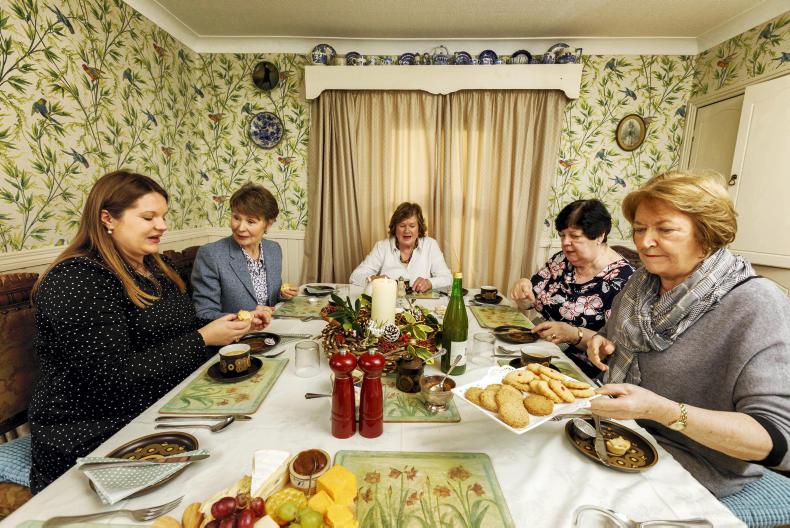




 This is a subscriber-only article
This is a subscriber-only article





SHARING OPTIONS: